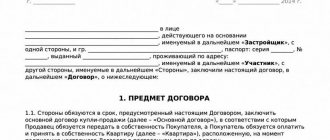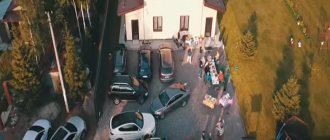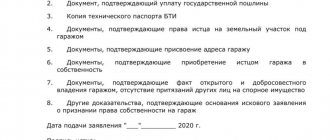Many city residents have summer cottages outside the city on the territory of non-profit gardening partnerships (SNT). However, ownership of a land plot does not give the owner the right to dispose of it at his own discretion without proper registration. This means that all plots with residential buildings that were obtained before 2001, i.e., before the adoption of the Land Code and were not included in Rosreestr, are not the property of the owner and can officially go to the state. This article will tell you how to register land ownership, what documents are needed for registration, and how much the procedure for registering a summer cottage will cost the owner.
To avoid problems with a summer cottage, it must be registered
What is a garden plot
This is a plot of land that is classified as an agricultural area and is intended for gardening. On such a site you can build a permanent residential building and register it if the property is registered.
Most garden plots are part of SNT - a garden non-profit partnership. Such plots belong to municipalities and are allocated to citizens on the following basis:
- Long-term rental;
- Perpetual inheritable ownership;
- Indefinite use.
Registration of an abandoned site
You can often find abandoned plots in gardening communities. If the user of such a plot of land has not been issued any certificate confirming his right to this land, the legislation provides for the option of assigning the abandoned plot to the new owner.
The chairman of the gardening partnership holds a meeting at which SNT members vote to seize abandoned land from the current owner and assign the plot to another member of this partnership. The procedure for its registration is carried out in the manner prescribed by law.
Conditions of registration
A simplified registration of ownership of a dacha plot is allowed. In accordance with the Land Code of the Russian Federation, a plot of land can become the private property of a participant in a dacha association free of charge. The owner will not have to pay the full price. But you need to pay a state fee for the production of a cadastral passport and registration actions in Rosreestr.
Acquiring property is permitted in the following cases:
- The plot is part of a dacha cooperative or other citizens' association;
- The land was allocated to the dacha cooperative before the Land Code of the Russian Federation came into force in 2001;
- The cooperative decided to redistribute plots between participants;
- The site was not limited in circulation or withdrawn from it, and was not reserved for state, municipal or military needs.
The simplified registration procedure under the so-called law “On the Dacha Amnesty” is valid until the end of 2021. For this reason, it is better not to delay registration until the end of the period, as this limits the ability to dispose and does not allow the land to be sold at a higher price. By the end of the term, the number of people wishing to receive property may increase, so you should hurry.
Features of receipt and registration
The registration of a summer cottage by its owner has a number of features in carrying out this procedure.
First of all, it is worth noting that from the beginning of 2021, the procedure for re-registration of a garden plot can be carried out in a simplified form under certain conditions:
- the plot must be allocated to a cooperative before 2001;
- the plot must belong to the owner who plans to re-register it;
- the garden plot should not be under state reserve or turnover.
Registration procedure
To register a garden plot as your property, two methods are used:
- Free privatization;
- Allocation of a share from joint ownership in SNT.
If the plot is part of collective property, the right can be obtained by purchasing a share or share. The procedure is carried out in the following way:
- First, you need to publish an announcement in the local media about the planned allocation of a share of land;
- If the participants in common ownership do not submit an objection within 1 month, boundary work is carried out to determine the boundaries of the site;
- The cadastral engineer will determine the boundaries and check that they do not overlap neighboring areas;
- Based on the results of the work, a boundary plan and cadastral passport are drawn up;
- Next, you should contact Rosreestr with documents to register the property and register the plot as a separate plot for cadastral registration.
If the SNT is small, it is not necessary to send an advertisement to the media. It is sufficient to send written notice to each participant.
Pros and cons of buying a plot using a garden book
Like any real estate purchase, buying a plot using a garden book has its pros and cons.
The advantages include:
- SNT land plots are valued more expensive than other dacha cooperatives. The quality of their land is higher than that of others.
- In order to create SNT, the state usually provides land located in an ecologically clean area with high-quality soil;
- On SNT plots people usually engage in agriculture - growing vegetables and fruits. There is no need to build houses.
- The price of a plot in SNT is lower than if you buy just a plot of land.
As for the disadvantages, it is worth noting the following:
- If you are planning to build a house, then purchasing a plot of land on the territory of SNT is not advisable. These types of plots are used only during crop growing seasons.
- It is impossible to register on the territory of the garden plot, even if you build a house.
- Banks do not issue loans for the purchase of garden plots. Such practices are very rare; loyalty and lending programs are not provided for such types of purchases, so the rate may be high if the bank decides to buy.
- If you come to install your own communications - electricity, sewerage, be prepared to pay a lot.
Required documents
First of all, you need to get a positive decision from the local administration. To do this, submit the following package of documents:
- Layout of the site next to neighboring ones;
- Extract from the protocol on the allocation of a plot for the owner, drawn up at the general meeting of SNT participants.
In order to safely register ownership of a garden plot, the following documents are submitted to the nearest branch of Rosreestr:
- Civil passport of the owner;
- Statement of the established form;
- A document of title, which can be a privatization document or a decision of the administration to provide ownership of a plot of land;
- Cadastral passport;
- Certificate about the date of joining the cooperative, the size of the allocated plot and the absence of debts to SNT;
- Boundary plan;
- Declaration for buildings (filled out in person);
- Receipt for payment of state duty.
If the necessary documents are provided and there are no contradictions in them, the registrar will register the plot of land and register ownership.
How to get a garden plot and use the land in a partnership
If you are not the owner of a garden plot and want to purchase it, then you need to:
- be a member of the SNT, which owns the plots. Then you need to contact the head or chairman of this SNT with a request to allocate you some land on the territory of this partnership.
- If you are not a member of the SNT, you can contact the relevant government agency with an application to obtain the right to a garden plot. Most likely, the applicant will have to go through a bidding procedure.
Obtaining a title document
The stage of collecting documents requires special attention. If at least one of them is missing, property registration may be refused. The most important of these is the title document. It confirms the fact that the citizen has received land. In the case of designing a garden plot, the following can be used:
- Certificate of right to lifelong inheritable ownership or permanent perpetual use. The document is issued for a plot allocated by the municipality within its territory.
- An act granting land for lifelong inheritable possession or permanent perpetual use. The document is issued by the local government authority.
- An old-style certificate of ownership of a plot, which takes the form of a separate document indicating the owner’s details, cadastral number and full address of the plot.
- An extract from the household register indicating the rights to the land plot. It is issued if the land is provided to a citizen for personal farming.
The title document must be drawn up first. It acts as the main confirmation of ownership and the basis for its emergence. In the event of a legal dispute, it is difficult to prove your position without it.
If the title document was previously issued and lost, it must be restored. To do this, you should contact Rosreestr or the local administration. The owner's passport and other documents confirming ownership of the plot are provided.
If the document is nowhere to be found, you will have to apply to the district court at the location of the garden plot to recognize ownership. It is important to correctly draw up a statement of claim, indicating detailed information about the date and features of obtaining the site. At the end of the appeal, a request is indicated to provide ownership of the plot.
Supporting documents and evidence are attached to the claim. It is better to attach as large a list as possible. These could be receipts for payment of membership fees and utilities, a garden book, payment documents or a contract for repair work or construction of buildings, if any. In case of a positive outcome, a court decision is issued, which is submitted to Rosreestr or MFC as a title document.
Who can privatize land
The following citizens have the right to privatize a land plot:
- a citizen who is a member of a specific SNT to which the garden plot belongs;
- the person must be an adult. Only individuals over 18 years of age can apply for land.
For privatization you will need the following package of documents:
- a document that confirms the right of ownership of the land plot;
Depending on the situation, this document may take the following forms:
- a deed issued by a local government body that gives ownership of a plot for life;
- a certificate that confirms the owner’s right to this site and is issued by the municipal service;
- certificate of ownership is still old, Soviet-style;
- protocol, court decision. Legal documents confirming ownership.
- Declaration for outbuildings existing on the territory. They can be sheds, garages, bathhouses, garden houses.
- Cadastral plan.
Obtaining a cadastral passport
It is provided in the form of a map containing information about the boundaries of the land plot. The document contains graphic and descriptive sections. It is necessary to confirm the boundaries of the site. Until 2008, a cadastral plan was issued by the Cadastral Chamber. Today you can order the issuance of a cadastral passport at the local branch of Rosreestr.
If there is no cadastral passport, an extract is issued stating that the plot does not have a cadastral number and is not registered with the state. This means that documents on the site were not previously provided and they are not in the state real estate register.
In this case, the boundaries of the site must be surveyed with the involvement of a cadastral engineer. He needs to provide the available documents. If necessary, he will request additional information from government agencies. You will have to pay for the service yourself. In addition, it is necessary to obtain signatures from the owners of adjacent plots that they agree with the definition of the boundaries at their location. If there is a claim, land surveying will have to be postponed until the trial.
If neighbors refuse to sign and do not make contact, without showing disagreement, it is enough to notify them in writing about the planned land survey. In this case, notifications about sending notices are attached to the land surveying act.
Why do you need to register garden real estate?
Registration of a garden plot is necessary in order to:
- if you inherited or bought or were given a plot of land;
- for the privatization of a plot of land that was the property of either the state or another municipal institution;
Registration of a garden plot is also a procedure for obtaining permission to own a given area. When registering the right to it, the owner subsequently has the right to transfer it to a site for individual construction.
Can a member of SNT not be the owner of a land plot? If this happens, what should I do?
It happens that a member of the SNT is not the owner of a plot of land in a garden cooperative, but is a member of it. How does this happen? If a member of the SNT was previously the owner of a plot, and later sold it, but did not withdraw from his membership, he retains the right to be a member. Therefore, when selling, a member of the SNT must write a statement of resignation from the cooperative.
Declaration for buildings
It is provided for all buildings, such as a garden house and outbuildings - a garage, a bathhouse and other capital objects. According to Art. 17 of the Town Planning Code of the Russian Federation, simplified registration is allowed only for those objects for the construction of which a permit is not required. These include a country or garden house, a separate bathhouse, a sauna, and a garage.
If a permanent residential building is being built, a declaration alone will not be enough. Additionally, a permit is required, which is issued before the start of construction work. The declaration is drawn up by the owner and includes descriptions of existing outbuildings. The document is drawn up in 2 copies separately for each object. You can use the declaration form.
Registration of a plot of land as shared ownership
Let's consider step by step how to register a share of a land plot as property.
Step 1. Repeated surveying
In order to register part of the land plot as property, you first need to re-conduct land surveying to divide the plot into parts. All plots obtained as a result of land surveying must have an entrance, and plots of individual housing construction and industrial buildings must have the necessary engineering communications.
Step 2. Agreement on division of the plot
Next, it is necessary to draw up an agreement on the division of the land plot, which must be signed by all owners of the new plots. The agreement must indicate:
- Cadastral number and information about all owners;
- The size of the shares and the area of the new plots, their correspondence to the shares in the original plot;
- Distribution of expenses for shared ownership.
If one of the owners refuses to divide the plot, the dispute can be resolved in court.
Step 3. Application for obtaining addresses
You need to submit an application for obtaining addresses for allocated land plots (contact the land management office of the local administration). The application shall indicate the name of the plots, their number and the grounds for assignment. You can also contact Rosreestr, MFC, and the public services portal. The decision on assigning a new address or refusal will be ready within 18 days.
Step 4. Collection of documents and registration
Registration of a share of a land plot in ownership includes all the same standard steps, only an agreement between the shareholders is added to the necessary documents.
During the procedure for dividing a land plot in Rosreestr, the following operations will be performed simultaneously:
- Inclusion of the site in the state real estate cadastre (GKN);
- Registration of property rights;
- Removal of the old site from the state conservatory;
- Termination of property rights.
Registration of ownership
First you need to contact the administration at the location of the site. The application with documents is considered within 14 days. As a result, a decision is issued to provide land or refuse privatization. An act of transfer of the site is issued indicating its exact location and technical characteristics. This is important so that it can be accurately identified among neighboring plots.
Next, a cadastral passport is issued, the preparation of which takes up to 5 working days. At the final stage, state registration is carried out in Rosreestr, which is carried out within a maximum period of 7-9 working days. After receiving an extract from the Unified State Register of Real Estate, the owner receives full rights to dispose of the site.
To complete the registration, you need to submit the collected package of documents to Rosreestr or through a convenient branch of the MFC. The state fee for carrying out registration actions in the amount of 2000 rubles is paid in advance. A standard application form can be taken from the employee and filled out on the spot.
The employee accepts the documents, provides a receipt for their receipt and sets a date when he can appear again. It takes up to 7 days to register property through Rosreestr; if documents are submitted to the MFC, it takes another 2 days. This is due to the time required to send documents.
The next time you apply for a receipt, documents and an extract from the Unified State Register are issued, which indicates the name of the owner.
At each stage of obtaining documents, it is necessary to check the correctness of the information about the site and the owner’s passport data. It’s easier to immediately submit documents for correction. Otherwise, the documents will be invalid. In the event of a legal dispute or the need to sell the land, you will first have to re-register the documents.
How to register a leased plot as property
According to Federal Law No. 178 “On State Social Assistance,” a citizen has the right to register a leased land plot as his own, i.e. privatize land that was originally leased (indefinitely or urgently).
You can register a plot for free if:
- You have built a country house, bathhouse, garage or outbuilding and become the owner of the property;
- You have built and become the owner of a private house;
- You are a member of a gardening cooperative.
You can get a plot of land for free if you are related to the following categories of citizens:
- Disabled people;
- BOB Veterans;
- Orphans;
- Large families;
- Military personnel who served more than 10 years;
- Police officers with more than 15 years of experience;
- Young agricultural workers;
- and other categories of beneficiaries.
You can also get land for free if the ownership of the house was registered before 10/30/2001.
To register ownership of a plot of land under lease, you must submit an application with an extract from the cadastral plan to the local municipal authority in charge of the land. Depending on the circumstances, the administration may make the following decisions:
- Transfer ownership of land free of charge, while issuing a permit in the prescribed form;
- Offer to buy the land and submit a purchase and sale agreement for consideration, and after the purchase, register the site;
- Reject the application if you do not have the rights of the owner (in accordance with Article 28 of the Land Code), or the site was not used for its intended purpose.
In general, the further procedure for registering a leased plot as a property does not differ from the usual one. The required documents will only be supplemented with a municipal permit (or a purchase and sale agreement).
The land was inherited
It happens that ownership of land is inherited, but the previous owner did not register the right through Rosreestr. In this case, you must first submit an application for inheritance.
Next, you need to contact Rosreestr for an extract from the Unified State Register and obtain a cadastral passport. Information is provided about the absence or presence of buildings, and the estimated value is established. This data is necessary to determine the volume of property and the amount of state duty for inheritance. It is also important to confirm the relationship, for which a marriage certificate, birth certificate or other certificates are provided.
Six months after the opening of the inheritance case, the notary issues a corresponding certificate. You should contact the administration with a complete set of documents to obtain a privatization document. After this, you should contact Rosreestr for the final transfer of ownership.
As a result, to register ownership of garden land, you need to collect documents from SNT and the local administration. After this, they are submitted along with the application to Rosreestr. If everything is in order and a complete package of documents is submitted, the plot is registered in the cadastral register and the ownership is registered. Then you can fully manage the land - sell, donate or transfer for use under a formal lease agreement.
Why do you need to design a summer cottage?
Amendments made to Russian legislation confront owners of suburban land plots and residential buildings on their territory with the need to register them. Without properly registered ownership of a dacha plot, it will not be possible to perform the following actions with them:
- sell or rent;
- draw up deeds of gift and will;
- present as collateral to obtain a loan;
- draw up an insurance contract;
- connect the necessary communications.
In order to avoid these situations, controversial issues with neighbors regarding the boundaries of the plot, as well as recognition of the dacha plot as illegal with its subsequent rejection in favor of the state, registration of the dacha house and land plot is necessary.
How to register a plot of land under the “dacha amnesty”?
As practice shows, most landowners do not have properly executed land documents. And many people think about registering their rights only when they decide to sell their land or when someone has encroached on it. Meanwhile, in some cases it is possible to draw up documents for a plot of land in a simplified version, under the current “dacha amnesty”.
According to various sources, almost half of the plots in our country are not registered. And the Krasnoyarsk Territory is no exception in this regard.
“Most land users, as a rule, do not have properly executed documents for a land plot,” says Elena Dudko, head of the department for administrative disputes. “There are three main cases here, which differ depending on the complexity of the situation. First, when land users have at least some documents for a land plot, as a rule, they were issued to the previous owner decades ago, after which the plot was inherited, its current owners believe that the agreement for perpetual use of the 60s, which they have on hands, enough to dispose of the land, and do not take any action in order to draw up documents in accordance with the law. The second large category of land owners has a certificate of ownership of this plot, but its boundaries are not defined, that is, although the plot is assigned a cadastral number, it is not possible to individualize it. Therefore, if the administration forms land, for example, to provide preferential categories of the population (disabled people or large families), it will not see its boundaries and can include part of the site in the allotment being formed. Today there are many such examples. And the third, most difficult situation is when land users do not have any documents for the land at all. In this case, you need to immediately contact either the village council archives or the city archives and look for information about who was originally given this plot. Try to find at least some documents indicating that this land plot was once provided to the testator. If there is still no evidence, it is possible in court, with the help of witness testimony (for example, neighbors), to prove that the family has been using the land plot for 15 years, cultivating it, and bearing the burden of expenses for its maintenance. Of course, this is an extreme case, and in most situations you should try to resolve the issue without going to court. In any case, land users should not wait until something happens to the site; it is better to check to what extent the title documents have been drawn up, whether its boundaries have been defined, so that similar incidents do not happen in the future and then they do not have to go to court.
Moreover, in a number of cases, it is possible today to register ownership of land and the buildings located on it in a simplified manner, under the current “dacha amnesty”.
What areas can be registered as property in a simplified manner?
As part of the “dacha amnesty,” it is possible to register ownership of plots provided for personal subsidiary plots, dacha farming, gardening, individual housing and individual garage construction. If the site was provided for other purposes, for example, not for the construction of an individual garage, but for a complex of garages, it cannot be registered in a simplified manner. For the same reason, the simplified procedure does not apply to land plots provided by SNT (the simplified procedure is provided for plots provided to citizens, and gardening plots were initially provided to groups, gardening partnerships and only then were divided into separate plots between specific individuals - members of gardening organizations).
In addition, in order to register land in a simplified manner, the right holder must own it under the right of ownership, lifelong inheritable possession or permanent (perpetual) use, or the document held by the land user must not indicate the right, or the type of such right cannot be determined . Important condition: land documents must be issued before October 30, 2001 (the moment the Land Code of the Russian Federation came into force).
What documents are needed to register a plot?
The state registration procedure is currently regulated by Federal Law No. 122-FZ “On state registration of rights to real estate and transactions with it”, paragraph 2 of Article 25.2 of which establishes the widest possible list of documents that indicate the granting of rights to a land plot. A land user can register rights within the framework of the “dacha amnesty” if he has one of the listed title documents: an act on the provision of a land plot to a citizen, issued by a state authority or local government body, a certificate (act) of the right to a land plot, issued by an authorized state authority , an extract from the household register (if the land plot was provided for personal farming), another document establishing or certifying the applicant’s right to the land plot. The simplified procedure assumes that the land user will be able to register the rights to the plot without carrying out a rather expensive land surveying procedure.
To register rights to a land plot, in addition to the title documents listed above, you must provide an application for state registration of ownership and a receipt for payment of the state registration fee (cost - 350 rubles) to the Rosreestr Office for the Krasnoyarsk Territory. The registration period is eight working days.
Special case of land registration
In addition, the “dacha amnesty” provides an opportunity to register land plots for owners of residential buildings who received them by inheritance or became their owners as a result of any transactions. According to paragraph 7 of Article 25.2 of Federal Law No. 122-FZ “On state registration of rights to real estate and transactions with it”, rights to land can be registered in a simplified manner even if the applicant is the owner of a building (structure) located on this site or buildings and, in addition to the document on the ownership of the building, has a document from any previous legal holder of the land plot (this can be either the testator himself or his predecessor), indicating that he was provided with this land.
“For example, being an heir, a person received a house, there is a certificate of inheritance rights to the house, but the fact of transfer of the land plot is not recorded anywhere, while there is a document from any previous owner of the land plot, for example, an act on the development of the land plot or any other document of any the previous legal owner of the land plot, confirming that this land was once provided to someone for the construction of this house,” explains Elena Kats, head of the legal support department of the Rosreestr Office for the Krasnoyarsk Territory.
Disadvantages of the “dacha amnesty”
The expiration date for land registration under a simplified procedure (under the “dacha amnesty”) is not limited. At the same time, owners involved in registering land in this way must take into account that the “dacha amnesty”, which has accelerated and simplified the registration of land plots, making the procedure cheaper, also has its negative consequences: recently the number of disputes about the boundaries of plots for which land surveying was carried out. “Today, the applicant comes to us with a title document received before 2001, and we carry out state registration without suspending it due to the lack of information in the state real estate cadastre about the coordinates of characteristic points of the boundaries of the plot or when one of the boundaries of the land plot crosses the boundaries of another land plot in accordance with the information about the latter entered into the state real estate cadastre (both boundaries and intersections are identified during the land surveying process). Then, after a few years, the owner begins to carry out land surveying and sees that the boundaries of his property are superimposed on the boundaries of the neighboring one, disputes begin between neighbors about boundaries even if they have registered rights, such lawsuits can last for years,” explains the head of the legal support department of the Rosreestr Office for Krasnoyarsk edge Elena Kats.
How to register a house in a simplified manner?
Under the “dacha amnesty”, it is also possible to register capital construction projects located on garden, vegetable plots, dacha plots, as well as individual construction projects located on plots for individual housing construction (IHC) and personal farming.
The deadline for registering ownership of objects located on garden, vegetable and summer cottage plots under a simplified procedure is not limited. For registration of individual housing construction projects in a simplified manner, which are located on private plots and private housing construction, the period of “dacha amnesty” expires on March 1, 2018. Until this moment, in order to register ownership of the object, the copyright holder does not need to obtain permission to put the object into operation; after this date (if the “dacha amnesty” is not extended once again) permission to put the individual housing construction object into operation will be required.
Today, in order to register ownership of a country house in a simplified manner, first the right to the land is registered, then the ownership of the constructed object. (In this case, the applicant can immediately submit documents to the Rosreestr Office for registration of land and house, but the right to the object will be issued only after the right to the land has been registered.)
According to Article 25.3 of the law on state registration, for state registration of any created (created) real estate object, for the construction of which it is not necessary to obtain a construction permit, a declaration is required - a document containing a description of the constructed building, which the owner fills out independently, and a title document for the land.
In the declaration, the owner will have to indicate the location (address) of the object, its purpose, area, number of floors (including underground), year of construction, materials of the external walls of the real estate object.
“The applicant independently fills out the declaration and is responsible for the information included in this declaration. He must be aware that it is with these characteristics that this object will then be put on state cadastral registration. All subsequent changes to this object are possible only through changing the state cadastral registration data. Therefore, we would like applicants to take full responsibility when filling out the declaration. Very often, applicants want to register sheds, bathhouses, and greenhouses located on the site in a simplified manner, but they must be aware that they all become real estate objects in respect of which the owners subsequently have an obligation to bear the burden of maintaining their property, including tax obligations.” , says Elena Kats.
Documents for registration of land rights in a simplified manner:
1. Application for state registration of property rights (the form can be downloaded on the Rosreestr website, obtained from the Rosreestr office or the MFC).
2. Identity document of the applicant.
3. One of the documents that serves as the basis for registering ownership of a plot: an act on the provision of a land plot to a citizen, issued by an authorized body of state power or local government; an act (certificate) of a citizen’s right to a land plot, issued by an authorized government body in the manner established by the legislation in force at the place of publication of such an act at the time of its publication; an extract from the household register indicating that the citizen has the right to a land plot (for plots provided for personal farming); another document establishing or certifying a citizen’s right to a land plot.
4. Document confirming payment of the state fee for registration (350 rubles). If this document was not provided by the applicant, Rosreestr itself will request payment information.
5. If the applicant owns a building (structure) or structure located on the land plot (this right was received by inheritance) or for other reasons, then for state registration of the right to the land plot a certificate of inheritance right or other document is provided , establishing ownership of the building (the document is not required if the right is registered in the Unified State Register of Rights to Real Estate). And also one of the documents for the land plot (from the list given in paragraph 3) of any previous owner of the building (structure) or structure.
For state registration of rights to a land plot in a simplified manner, a cadastral passport of the land plot is not required.
Where to submit documents?
Documents for registration of property can be submitted to the branches of the Federal Cadastral Chamber of the Rosreestr Office in the Krasnoyarsk Territory at the following addresses:
- st. Podzolkova, 3;
- st. Dubrovinsky, 114;
- Fifty-second quarter, 3.
And also in all Multifunctional centers for the provision of municipal and government services (MFC) at the addresses:
- Krasnoyarsky Rabochiy Ave., 44;
- Krasnoyarsky Rabochiy Ave., 70;
- st. May 9, 12;
- st. Zheleznodorozhnikov, 15;
- st. Karamzina, 25;
- st. Kirova, 43;
- st. Popova, 8;
- st. Television, 1, p. 9.










